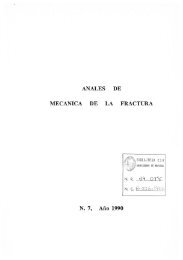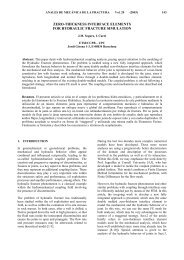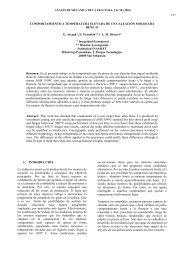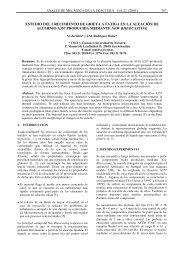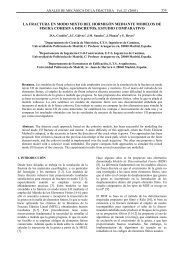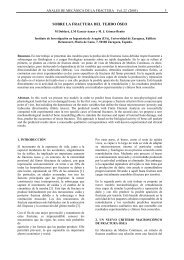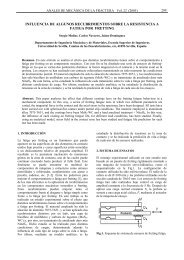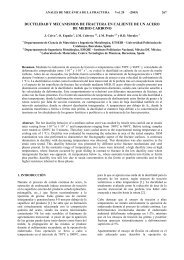resistencia al choque térmico de materiales de alúmina-mullita
resistencia al choque térmico de materiales de alúmina-mullita
resistencia al choque térmico de materiales de alúmina-mullita
Create successful ePaper yourself
Turn your PDF publications into a flip-book with our unique Google optimized e-Paper software.
190<br />
ANALES DE MECÁNICA DE LA FRACTURA, Vol. 18, (2001)<br />
RESISTENCIA AL CHOQUE TÉRMICO DE MATERIALES DE ALÚMINA-MULLITA<br />
S. Mezquita, R. Uribe, R. Moreno, C. Baudín<br />
Instituto <strong>de</strong> Cerámica y Vidrio, CSIC<br />
Departamento <strong>de</strong> Cerámica<br />
Antigua Crtra. <strong>de</strong> V<strong>al</strong>encia km 24.300, Arganda <strong>de</strong>l Rey, 28500 Madrid<br />
Resumen. En este trabajo se propone la adición <strong>de</strong> pequeñas cantida<strong>de</strong>s <strong>de</strong> <strong>mullita</strong> (≤15%vol) a la<br />
<strong>al</strong>úmina como medio para disminuir las tensiones térmicas creadas en el materi<strong>al</strong> <strong>de</strong>bido a cambios<br />
bruscos <strong>de</strong> temperatura. Se han fabricado, por métodos coloid<strong>al</strong>es, materi<strong>al</strong>es compuestos <strong>de</strong> <strong>al</strong>úmina<strong>mullita</strong><br />
<strong>de</strong>nsos (>97%ρ t ) y con pequeño tamaño <strong>de</strong> grano (≤3µm). Se ha caracterizado su microestructura<br />
y se ha ev<strong>al</strong>uado la <strong>resistencia</strong> teórica frente <strong>al</strong> <strong>choque</strong> térmico a partir <strong>de</strong> las siguientes propieda<strong>de</strong>s:<br />
módulo <strong>de</strong> elasticidad, K IC , coeficiente <strong>de</strong> expansión térmica y conductividad térmica. Se ha caracterizado<br />
la <strong>resistencia</strong> <strong>al</strong> <strong>choque</strong> térmico <strong>de</strong>l materi<strong>al</strong> compuesto con mayor <strong>resistencia</strong> teórica y comparado con la<br />
<strong>de</strong> un materi<strong>al</strong> <strong>de</strong> <strong>al</strong>úmina <strong>de</strong> referencia, para lo cu<strong>al</strong> se ha puesto a punto un método <strong>de</strong> enfriamiento<br />
brusco <strong>de</strong> probetas previamente in<strong>de</strong>ntadas. Los resultados obtenidos muestran un buen acuerdo con las<br />
predicciones teóricas, en particular, el materi<strong>al</strong> compuesto presenta un v<strong>al</strong>or superior (≈15%) <strong>de</strong><br />
incremento <strong>de</strong> temperatura crítico que el materi<strong>al</strong> <strong>de</strong> <strong>al</strong>úmina <strong>de</strong> referencia.<br />
Abstract. The objective of this work has been to improve the therm<strong>al</strong> shock resistance of <strong>al</strong>umina<br />
materi<strong>al</strong>s by the addition of sm<strong>al</strong>l amounts of mullite (≤15vol%). Dense (>97%ρ t ) and fine grained<br />
(≤3µm) <strong>al</strong>umina-mullite composites have been prepared by colloid<strong>al</strong> routes. The microstructure of the<br />
materi<strong>al</strong>s has been characterised and their theoretic<strong>al</strong> response to therm<strong>al</strong> shock has been ev<strong>al</strong>uated from<br />
Young´s modulus, K IC , therm<strong>al</strong> expansion and therm<strong>al</strong> conductivity. The therm<strong>al</strong> shock behaviour of the<br />
materi<strong>al</strong> with the highest c<strong>al</strong>culated resistance has been <strong>de</strong>termined and compared to that of a reference<br />
<strong>al</strong>umina materi<strong>al</strong>. A speci<strong>al</strong>ly <strong>de</strong>veloped therm<strong>al</strong> shock test of in<strong>de</strong>nted samples has been used. A good<br />
agreement between theoretic<strong>al</strong> predictions and the obtained results has been found. The critic<strong>al</strong><br />
temperature increment for failure of the composite materi<strong>al</strong> is increased 15% with regard to that of the<br />
reference <strong>al</strong>umina.<br />
1. INTRODUCCIÓN<br />
Los materi<strong>al</strong>es <strong>de</strong>nsos <strong>de</strong> <strong>al</strong>úmina presentan una<br />
excelente <strong>resistencia</strong> a la <strong>de</strong>formación y <strong>al</strong> <strong>de</strong>sgaste,<br />
siendo su mayor limitación la baja <strong>resistencia</strong> <strong>al</strong> <strong>choque</strong><br />
térmico.<br />
Las tensiones térmicas <strong>de</strong>sarrolladas en una pieza <strong>de</strong> un<br />
materi<strong>al</strong> elástico sometido a un cambio brusco <strong>de</strong><br />
temperatura son proporcion<strong>al</strong>es <strong>al</strong> producto <strong>de</strong>l<br />
coeficiente <strong>de</strong> expansión térmica, α, y <strong>de</strong>l módulo <strong>de</strong><br />
elasticidad, E. La respuesta <strong>al</strong> <strong>choque</strong> térmico <strong>de</strong> los<br />
materi<strong>al</strong>es frágiles, en términos <strong>de</strong> máximo incremento<br />
<strong>de</strong> temperatura que una pieza pue<strong>de</strong> sufrir sin que se<br />
produzca la fractura, está <strong>de</strong>scrita por el parámetro<br />
clásico, R [1]:<br />
R ≈ σ f (E α) -1 (1)<br />
Así, una segunda fase que disminuyera los términos E y<br />
α, <strong>de</strong>bería mejorar la respuesta <strong>al</strong> <strong>choque</strong> térmico <strong>de</strong>l<br />
materi<strong>al</strong>.<br />
La <strong>mullita</strong> (3Al 2 O 3 .2SiO 2 ) es compatible en estado<br />
sólido con la <strong>al</strong>úmina y presenta v<strong>al</strong>ores <strong>de</strong> E y α<br />
inferiores a los <strong>de</strong> la <strong>al</strong>úmina (E≈200 y 400 GPa,<br />
α≈4.5 . 10 -6 y 9 . 10 -6 ºC -1 ). Sin embargo, sus propieda<strong>de</strong>s<br />
mecánicas son inferiores (K IC ≈2-3 MPa . m 1/2 , H≈10-15<br />
GPa).
ANALES DE MECÁNICA DE LA FRACTURA, Vol. 18, (2001)<br />
191<br />
En este trabajo se propone la adición <strong>de</strong> pequeñas<br />
concentraciones <strong>de</strong> <strong>mullita</strong> como fase dispersa (5-<br />
15%vol) en una matriz <strong>de</strong> <strong>al</strong>úmina como método para<br />
aumentar la respuesta <strong>de</strong> ésta a las tensiones térmicas,<br />
sin <strong>al</strong>terar significativamente su comportamiento<br />
mecánico. La preparación <strong>de</strong> los materi<strong>al</strong>es se ha<br />
llevado a cabo por métodos coloid<strong>al</strong>es para asegurar un<br />
máximo nivel <strong>de</strong> empaquetamiento y uniformidad<br />
microestructur<strong>al</strong> [2].<br />
2. EXPERIMENTAL<br />
2.1 Preparación <strong>de</strong> los materi<strong>al</strong>es<br />
Se han utilizado los siguientes polvos comerci<strong>al</strong>es <strong>de</strong><br />
<strong>al</strong>ta pureza: <strong>al</strong>úmina Con<strong>de</strong>a HPA 05 (EEUU) y <strong>mullita</strong><br />
Baik<strong>al</strong>ox, Baikowski (Francia), cuyos tamaños medios<br />
<strong>de</strong> partícula son 0.4 y 2.7µm, respectivamente. El polvo<br />
<strong>de</strong> <strong>mullita</strong> fue molido por atrición hasta <strong>al</strong>canzar un<br />
tamaño medio <strong>de</strong> 0.7µm.<br />
Se prepararon suspensiones acuosas <strong>de</strong> cada polvo con<br />
contenidos en sólidos <strong>de</strong> 37 %vol (70 y 65%peso <strong>de</strong><br />
<strong>al</strong>úmina y <strong>mullita</strong>, respectivamente). Como <strong>de</strong>floculante<br />
se empleó un poli electrolito (Dolapix CE64<br />
Zschimmer-Schwarz, Alemania). Cada suspensión se<br />
optimizó in<strong>de</strong>pendientemente, mediante medidas <strong>de</strong><br />
viscosidad, utilizando distintas concentraciones <strong>de</strong><br />
dispersante. Por último, se prepararon suspensiones <strong>de</strong><br />
<strong>al</strong>úmina con contenidos <strong>de</strong> <strong>mullita</strong> <strong>de</strong> 5, 10 y 15 %vol<br />
en las mejores condiciones <strong>de</strong> <strong>de</strong>floculación y un<br />
contenido en sólidos tot<strong>al</strong> <strong>de</strong> 65%peso (32.1-32.5<br />
%vol). Estas suspensiones se colaron en mol<strong>de</strong>s <strong>de</strong><br />
escayola para obtener los compactos en ver<strong>de</strong> (placas,<br />
10x10x1 cm 3 ) <strong>de</strong> los materi<strong>al</strong>es compuestos <strong>de</strong> <strong>al</strong>umina<br />
con 5, 10 y 15 %vol <strong>de</strong> <strong>mullita</strong> (A5M, A10M y A15M,<br />
respectivamente), que fueron tratados durante 2h a 1600<br />
y 1650ºC, utilizando velocida<strong>de</strong>s <strong>de</strong> c<strong>al</strong>entamiento y<br />
enfriamiento <strong>de</strong> 2ºC/min.<br />
2.2 Caracterización <strong>de</strong> los materi<strong>al</strong>es<br />
Las <strong>de</strong>nsida<strong>de</strong>s fueron <strong>de</strong>terminadas por el método <strong>de</strong><br />
Arquíme<strong>de</strong>s en mercurio y agua para las piezas en ver<strong>de</strong><br />
y sinterizadas, respectivamente.<br />
La caracterización microestructur<strong>al</strong> se re<strong>al</strong>izó, sobre<br />
muestras pulidas y atacadas térmicamente, utilizando<br />
microscopía electrónica <strong>de</strong> barrido (Zeiss DSM 950). El<br />
tamaño medio <strong>de</strong> grano fue <strong>de</strong>terminado directamente<br />
por el método <strong>de</strong> la intersección sobre microfotografías<br />
(5 superficies, 18x60 µm 2 ), sin re<strong>al</strong>izar ninguna<br />
corrección.<br />
se c<strong>al</strong>cularon a partir <strong>de</strong> los tamaños <strong>de</strong> las huellas<br />
producidas por in<strong>de</strong>ntación Vickers sobre superficies<br />
pulidas, utilizando una carga <strong>de</strong> 98 N durante 10 s (Leco<br />
Hardness Tester, Japón). Para c<strong>al</strong>cular los v<strong>al</strong>ores <strong>de</strong> K C<br />
se utilizó la ecuación <strong>de</strong> Miranzo y Moya [3].<br />
El coeficiente <strong>de</strong> expansión térmica se <strong>de</strong>terminó por<br />
dilatometría (Adhamel Lomargy, Francia) en un<br />
interv<strong>al</strong>o <strong>de</strong> temperatura <strong>de</strong> 25-600ºC. La difusividad y<br />
el c<strong>al</strong>or específico (25-400ºC) se <strong>de</strong>terminaron en un<br />
equipo <strong>de</strong> pulso láser (Holometrix Therm<strong>al</strong>flash,<br />
EEUU) utilizando discos <strong>de</strong> 12.7mm <strong>de</strong> diámetro y<br />
1mm <strong>de</strong> <strong>al</strong>tura. La conductividad térmica se c<strong>al</strong>culó a<br />
partir <strong>de</strong> estos v<strong>al</strong>ores y <strong>de</strong> la <strong>de</strong>nsidad <strong>de</strong> los<br />
materi<strong>al</strong>es.<br />
Para la caracterización <strong>de</strong> la respuesta frente <strong>al</strong> <strong>choque</strong><br />
térmico <strong>de</strong>l materi<strong>al</strong> A10M-1650ºC y <strong>de</strong> <strong>al</strong>úmina <strong>de</strong><br />
referencia se utilizaron discos <strong>de</strong> 11.9mm <strong>de</strong> diámetro y<br />
3mm <strong>de</strong> espesor con una <strong>de</strong> las caras pulida e in<strong>de</strong>ntada<br />
(98N) en su punto centr<strong>al</strong>. Las probetas se introdujeron<br />
en una cesta <strong>de</strong> Kanth<strong>al</strong> en un horno vertic<strong>al</strong> y se<br />
c<strong>al</strong>entaron a diferentes temperaturas utilizando 5ºC/min<br />
como velocidad <strong>de</strong> c<strong>al</strong>entamiento y 20min <strong>de</strong><br />
estabilización. Posteriormente, fueron enfriadas<br />
bruscamente, por inmersión en un baño <strong>de</strong> glicerina a<br />
40ºC. Los incrementos <strong>de</strong> temperatura utilizados han<br />
sido <strong>de</strong> 220 hasta 380ºC. Los tamaños <strong>de</strong> las grietas <strong>de</strong><br />
in<strong>de</strong>ntación, antes y <strong>de</strong>spués <strong>de</strong>l <strong>choque</strong> térmico, se<br />
midieron empleando microscopía óptica.<br />
3. RESULTADOS Y DISCUSIÓN<br />
3.1 Caracterización microestructur<strong>al</strong> y mecánica<br />
Las tablas I y II recogen las características<br />
microestructur<strong>al</strong>es y mecánicas <strong>de</strong> los materi<strong>al</strong>es<br />
compuestos.<br />
Tabla 1. Características microestructur<strong>al</strong>es <strong>de</strong> los<br />
materi<strong>al</strong>es compuestos en función <strong>de</strong> la temperatura <strong>de</strong><br />
sinterización, T. %ρ t =% <strong>de</strong>nsidad teórica, g med =tamaño<br />
medio <strong>de</strong> grano, g int =interv<strong>al</strong>o <strong>de</strong> tamaños <strong>de</strong> grano.<br />
A5M A10M A15M<br />
T(ºC) 1600 1650 1600 1650 1600 1650<br />
%ρ t 97.5 98.8 96.9 98.5 96.3 97.9<br />
g med<br />
(µm)<br />
0.8±<br />
0.6<br />
1.6±<br />
0.6<br />
0.9±<br />
0.3<br />
1.2±<br />
0.3<br />
1.1±<br />
0.2<br />
1.3±<br />
0.2<br />
El módulo <strong>de</strong> Young se c<strong>al</strong>culó a partir <strong>de</strong>l periodo<br />
propio <strong>de</strong> vibración <strong>de</strong> barras (4x5x50 mm 3 ) ensayadas<br />
por impacto en flexión (Grindosonic MK5 Industri<strong>al</strong>,<br />
Lemmens, Bélgica). La dureza, HV, y la tenacidad, K C ,<br />
g int<br />
(µm)<br />
0.5-<br />
1.8<br />
1.0-<br />
3.0<br />
0.5-<br />
1.6<br />
0.8-<br />
1.8<br />
0.9-<br />
1.2<br />
0.9-<br />
1.6
192<br />
ANALES DE MECÁNICA DE LA FRACTURA, Vol. 18, (2001)<br />
La figura 1 muestra la microestructura <strong>de</strong> los materi<strong>al</strong>es<br />
compuestos <strong>de</strong> mayor <strong>de</strong>nsidad y la <strong>de</strong> un materi<strong>al</strong> <strong>de</strong><br />
<strong>al</strong>úmina diseñado con <strong>de</strong>nsidad y tamaños <strong>de</strong> grano<br />
próximos, para que pueda ser utilizado como materi<strong>al</strong><br />
<strong>de</strong> referencia.<br />
Alúmina-1500ºC<br />
Tabla 2. Propieda<strong>de</strong>s mecánicas <strong>de</strong> los compuestos y<br />
<strong>de</strong>l materi<strong>al</strong> <strong>de</strong> <strong>al</strong>úmina <strong>de</strong> referencia. Como error se<br />
indica la <strong>de</strong>sviación estándar <strong>de</strong> 5 <strong>de</strong>terminaciones.<br />
A A5M A10M A15M<br />
T,ºC 1500 1600 1650 1600 1650 1600 1650<br />
HV,GPa 19.0±<br />
0.5<br />
18.6±<br />
0.7<br />
16.7±<br />
0.6<br />
16.0±<br />
0.5<br />
18±<br />
1<br />
17.0±<br />
0.3<br />
17.5±<br />
0.5<br />
A5M-1600ºC<br />
E,GPa 388±<br />
10<br />
363±<br />
10<br />
359±<br />
10<br />
351±<br />
10<br />
K C<br />
MPam 1/2 4.0±<br />
0.4<br />
4.0±<br />
0.4<br />
4.2±<br />
0.2<br />
4.1±<br />
0.7<br />
3.8±<br />
0.2<br />
3.9±<br />
0.2<br />
3.9±<br />
0.3<br />
Los v<strong>al</strong>ores <strong>de</strong> la dureza y <strong>de</strong>l módulo <strong>de</strong> elasticidad <strong>de</strong><br />
todos los compuestos son inferiores a los<br />
correspondientes a la <strong>al</strong>úmina <strong>de</strong> referencia. Los v<strong>al</strong>ores<br />
<strong>de</strong>l módulo <strong>de</strong> elasticidad presentan un buen acuerdo<br />
con los c<strong>al</strong>culados utilizando el límite <strong>de</strong> Voight para<br />
materi<strong>al</strong>es compuestos. La dureza está afectada por la<br />
<strong>de</strong>nsidad y la microestructura <strong>de</strong> los materi<strong>al</strong>es, a<strong>de</strong>más<br />
<strong>de</strong> por la composición. El caso más singular es el <strong>de</strong>l<br />
materi<strong>al</strong> A5M-1650ºC, el cu<strong>al</strong> presenta una dureza<br />
inferior a la <strong>de</strong>l materi<strong>al</strong> sinterizado a 1600ºC, a pesar<br />
<strong>de</strong> tener una porosidad tot<strong>al</strong> menor, <strong>de</strong>bido a la<br />
porosidad intragranular formada en el materi<strong>al</strong> como<br />
consecuencia <strong>de</strong>l crecimiento exagerado <strong>de</strong> grano.<br />
Dado que no existen diferencias apreciables entre los<br />
v<strong>al</strong>ores <strong>de</strong> la tenacidad y que los compuestos A5M-<br />
1600ºC, A10M-1650ºC y A15M-1650ºC presentan<br />
v<strong>al</strong>ores <strong>de</strong> dureza cercanos a los <strong>de</strong> la <strong>al</strong>úmina, se han<br />
seleccionado estos tres materi<strong>al</strong>es para su<br />
caracterización térmica.<br />
A10M-1650ºC<br />
A15M-1650ºC<br />
3.2 Planteamiento <strong>de</strong>l ensayo <strong>de</strong> <strong>resistencia</strong> <strong>al</strong> <strong>choque</strong><br />
térmico<br />
El análisis <strong>de</strong> las grietas simétricas formadas en los<br />
vértices <strong>de</strong> una in<strong>de</strong>ntación Vickers [4-5] muestra que el<br />
factor <strong>de</strong> intensidad <strong>de</strong> tensiones, K 0, en la punta <strong>de</strong> una<br />
grieta <strong>de</strong> tamaño C 0 formada <strong>de</strong>bido a una carga P viene<br />
dado por:<br />
K 0 = K C = χ r P C 0<br />
-3/2<br />
(2)<br />
Figura 1. Microestructuras características <strong>de</strong> los<br />
materi<strong>al</strong>es estudiados. Se señ<strong>al</strong>a composición y<br />
temperatura <strong>de</strong> sinterización.
ANALES DE MECÁNICA DE LA FRACTURA, Vol. 18, (2001)<br />
193<br />
Don<strong>de</strong> K C es el la tenacidad <strong>de</strong>l materi<strong>al</strong> y χ r es una<br />
constante que ev<strong>al</strong>úa la magnitud <strong>de</strong> las tensiones<br />
residu<strong>al</strong>es:<br />
χ r = ϕ r (E / H) 1/2 (3)<br />
ϕ r es una constante que <strong>de</strong>pen<strong>de</strong> <strong>de</strong> las características<br />
<strong>de</strong>l in<strong>de</strong>ntador.<br />
Cuando la probeta in<strong>de</strong>ntada se somete a enfriamiento<br />
brusco (<strong>choque</strong> térmico), se crea una tensión en la<br />
superficie <strong>de</strong> la pieza, σ T , que <strong>de</strong>pen<strong>de</strong> <strong>de</strong> la magnitud<br />
<strong>de</strong> la diferencia <strong>de</strong> temperatura, ∆T. La acción conjunta<br />
<strong>de</strong> esta tensión térmica y la tensión residu<strong>al</strong> da lugar <strong>al</strong><br />
siguiente factor <strong>de</strong> intensidad <strong>de</strong> tensiones:<br />
K = λ χ r P C -3/2 + σ T (Ω π C) 1/2 (4)<br />
Don<strong>de</strong> el término σ T (Ω π C) 1/2 es el factor <strong>de</strong> intensidad<br />
<strong>de</strong> tensiones correspondiente a una grieta semicircular y<br />
λ es un coeficiente <strong>de</strong> relajación <strong>de</strong> la tensión residu<strong>al</strong><br />
que varía entre 1 y 0. En gener<strong>al</strong>, esta constante se toma<br />
como 1 en los ensayos <strong>de</strong> <strong>choque</strong> térmico, lo cu<strong>al</strong> tiene<br />
sentido si no se produce agrietamiento later<strong>al</strong> en las<br />
muestras <strong>de</strong>bido a los cortos tiempos <strong>de</strong> estabilización<br />
y relativamente bajos v<strong>al</strong>ores <strong>de</strong> la temperaturas que se<br />
emplean.<br />
En condiciones <strong>de</strong> equilibrio, K igu<strong>al</strong>a a la tenacidad <strong>de</strong>l<br />
materi<strong>al</strong>, K C , y se obtiene la siguiente relación entre la<br />
tensión térmica y el tamaño <strong>de</strong> grieta (λ=1):<br />
σ T = K C . (Ω π C) 1/2 [1-(χ r P / K C C 3/2 )] -1 (5)<br />
Diferenciando σ T respecto a C, se <strong>de</strong>duce que la grieta<br />
inici<strong>al</strong> sufre una propagación estable, bajo el efecto <strong>de</strong><br />
la tensión térmica [6-7], hasta un v<strong>al</strong>or fin<strong>al</strong> C m :<br />
C m = (4 χ r P / K C ) 2/3 (6)<br />
C m /C 0 = 2.52 (7)<br />
La tensión asociada cuando C = C m es:<br />
σ m = 0.47 K C 4/3 /(π Ω) 1/2 (λ χ r P) 1/3 (8)<br />
Teniendo en cuenta las ecuaciones (2) y (4), se obtiene<br />
la siguiente relación entre la tensión térmica y los<br />
tamaños inici<strong>al</strong> y fin<strong>al</strong> <strong>de</strong> la grieta, en condiciones <strong>de</strong><br />
equilibrio:<br />
σ T = [χ r P (C 0 -3/2 – C -3/2 )] / (π Ω C) 1/2 (9)<br />
Osterstock y col [6-7] han propuesto utilizar ensayos<br />
sobre probetas in<strong>de</strong>ntadas para comparar la <strong>resistencia</strong><br />
<strong>al</strong> <strong>choque</strong> térmico relativa <strong>de</strong> diferentes materi<strong>al</strong>es. El<br />
procedimiento <strong>de</strong> estos autores consiste en someter<br />
probetas in<strong>de</strong>ntadas con cargas, P, variables a un<br />
incremento <strong>de</strong> temperatura fijo, ∆T. La curvas C/C 0<br />
frente a P reflejan la <strong>resistencia</strong> relativa.<br />
En este trabajo se propone un método diferente, que<br />
consiste en someter probetas con tamaños <strong>de</strong> grieta, C 0 ,<br />
igu<strong>al</strong>es a incrementos <strong>de</strong> temperatura, ∆T, crecientes.<br />
Las tensiones térmicas, σ T , creadas son función <strong>de</strong> ∆T:<br />
σ T = E α ∆T G (10)<br />
Don<strong>de</strong> el factor <strong>de</strong> proporcion<strong>al</strong>idad, G, incluye los<br />
términos geométricos y <strong>de</strong> transferencia <strong>de</strong> c<strong>al</strong>or. Para<br />
condiciones suaves <strong>de</strong> transferencia <strong>de</strong> c<strong>al</strong>or, G es<br />
función <strong>de</strong>l número <strong>de</strong> Biot, β=ah/k, siendo a y h la<br />
longitud característica y el coeficiente superfici<strong>al</strong> <strong>de</strong><br />
transferencia <strong>de</strong> c<strong>al</strong>or, respectivamente, y k la<br />
conductividad térmica <strong>de</strong>l materi<strong>al</strong>. Cuando el número<br />
<strong>de</strong> Biot es pequeño, se tiene:<br />
∆T = σ T k / g h E α (11)<br />
Don<strong>de</strong> g es una constante que <strong>de</strong>pen<strong>de</strong> <strong>de</strong> la geometría<br />
<strong>de</strong> la pieza y <strong>de</strong> la distribución <strong>de</strong> las tensiones.<br />
Las grietas crecerán <strong>de</strong> forma estable para incrementos<br />
<strong>de</strong> temperatura inferiores <strong>al</strong> incremento <strong>de</strong> temperatura<br />
crítico, ∆T C, para el cu<strong>al</strong> σ T =σ m (ec. 8):<br />
∆T C = σ m k / h g E α (12)<br />
Con objeto <strong>de</strong> ev<strong>al</strong>uar el posible efecto <strong>de</strong> las adiciones<br />
<strong>de</strong> <strong>mullita</strong> en la conductividad térmica <strong>de</strong> la matriz <strong>de</strong><br />
<strong>al</strong>úmina, en este trabajo se ha utilizado un método <strong>de</strong><br />
ensayo que implica condiciones <strong>de</strong> transferencia <strong>de</strong><br />
c<strong>al</strong>or suaves. La <strong>de</strong>terminación <strong>de</strong>l crecimiento relativo<br />
<strong>de</strong> grieta C/C 0 frente a interv<strong>al</strong>os <strong>de</strong> temperatura, ∆T,<br />
crecientes, proporcionará una ev<strong>al</strong>uación <strong>de</strong>l<br />
comportamiento relativo <strong>de</strong> los materi<strong>al</strong>es sometidos a<br />
<strong>choque</strong> térmico.<br />
3.3.- Propieda<strong>de</strong>s térmicas<br />
La ecuación (12)muestra que la <strong>resistencia</strong> <strong>al</strong> <strong>choque</strong><br />
térmico <strong>de</strong>pen<strong>de</strong> <strong>de</strong>l coeficiente <strong>de</strong> expansión térmica,<br />
α, y <strong>de</strong> la conductividad térmica, k, <strong>de</strong>l materi<strong>al</strong>. Estas<br />
dos propieda<strong>de</strong>s térmicas <strong>de</strong>terminan el nivel <strong>de</strong> las<br />
tensiones creadas en la pieza sometida a un cambio <strong>de</strong><br />
temperatura.<br />
Los v<strong>al</strong>ores <strong>de</strong> α, entre 25 y 600ºC, obtenidos fueron<br />
9.0±0.1, 8.7±0.1, 8.4±0.1, 8.3±0.1 . 10 -6 ºC -1 , para la<br />
<strong>al</strong>úmina, y los materi<strong>al</strong>es A5M, A10M y A15M<br />
seleccionados, respectivamente, resultados que<br />
confirman el efecto beneficioso <strong>de</strong> las adiciones <strong>de</strong><br />
<strong>mullita</strong> en lo que se refiere a disminución <strong>de</strong> este<br />
parámetro.<br />
En la figura 2 se representa la variación <strong>de</strong> k con la<br />
temperatura para los materi<strong>al</strong>es compuestos, la <strong>al</strong>úmina
194<br />
ANALES DE MECÁNICA DE LA FRACTURA, Vol. 18, (2001)<br />
<strong>de</strong> referencia y un materi<strong>al</strong> <strong>de</strong> <strong>mullita</strong> con 98.0% <strong>de</strong><br />
<strong>de</strong>nsidad teórica. Los v<strong>al</strong>ores obtenidos para los<br />
materi<strong>al</strong>es compuestos son muy cercanos a los <strong>de</strong> la<br />
<strong>al</strong>úmina y no presentan una variación sistemática con el<br />
contenido <strong>de</strong> <strong>mullita</strong>. Los v<strong>al</strong>ores correspondientes <strong>al</strong><br />
materi<strong>al</strong> A5M son siempre inferiores, lo cu<strong>al</strong> está<br />
relacionado con la menor <strong>de</strong>nsidad que presenta este<br />
materi<strong>al</strong> (tabla 1).<br />
Por lo tanto, se pue<strong>de</strong> construir un único gráfico σ T<br />
frente a C/C 0 para los cuatro materi<strong>al</strong>es, t<strong>al</strong> y como el<br />
mostrado en la figura 3, don<strong>de</strong> se ha tomado χ r =1 por<br />
simplicidad, C 0 =212µm, y Ω=4π para una grieta<br />
semicircular superfici<strong>al</strong>.<br />
200<br />
Conductivity (W/mK)<br />
35<br />
30<br />
25<br />
20<br />
15<br />
10<br />
Alumina<br />
A5M<br />
A10M<br />
A15M<br />
Mullite<br />
σ T<br />
(MPa)<br />
150<br />
100<br />
50<br />
0<br />
1.0 1.5 2.0 2.5 3.0 3.5<br />
C/C 0<br />
5<br />
0 100 200 300 400 500<br />
Temperature(ºC)<br />
Figura 2. Conductividad térmica <strong>de</strong> los materi<strong>al</strong>es<br />
estudiados. Asimismo, se representan los v<strong>al</strong>ores<br />
correspondientes a un materi<strong>al</strong> <strong>de</strong> <strong>mullita</strong> con 98% <strong>de</strong><br />
<strong>de</strong>nsidad teórica.<br />
El hecho <strong>de</strong> que k se vea más afectada por la porosidad<br />
que por la presencia <strong>de</strong> una fase para la cu<strong>al</strong> esta<br />
propiedad es un or<strong>de</strong>n <strong>de</strong> magnitud inferior se <strong>de</strong>be a las<br />
pequeñas cantida<strong>de</strong>s <strong>de</strong> <strong>mullita</strong> presentes, inferiores a la<br />
necesaria para que ocurra la percolación (≈20%vol). Por<br />
lo tanto, la presencia <strong>de</strong> <strong>mullita</strong> no supone una<br />
<strong>de</strong>gradación importante <strong>de</strong> las propieda<strong>de</strong>s <strong>de</strong> la<br />
<strong>al</strong>úmina en términos <strong>de</strong> transferencia <strong>de</strong> c<strong>al</strong>or.<br />
3.4.- Resistencia <strong>al</strong> <strong>choque</strong> térmico teórica<br />
Con objeto <strong>de</strong> ev<strong>al</strong>uar la <strong>resistencia</strong> <strong>al</strong> <strong>choque</strong> térmico<br />
teórica <strong>de</strong> los materi<strong>al</strong>es se ha tenido en cuenta que,<br />
cuando se utiliza una carga <strong>de</strong> in<strong>de</strong>ntación <strong>de</strong> 98N para<br />
crear la grieta inici<strong>al</strong>, el crecimiento <strong>de</strong> ésta bajo una<br />
tensión térmica dada (ecuación 9) va a ser igu<strong>al</strong> para los<br />
cuatro materi<strong>al</strong>es, ya que:<br />
i) los tamaños <strong>de</strong> grieta son coinci<strong>de</strong>ntes:<br />
201±15, 216±14, 220±14 y 210±16 µm para<br />
<strong>al</strong>úmina, A5M, A10M y A15M,<br />
respectivamente<br />
ii) los v<strong>al</strong>ores <strong>de</strong> E/H y, por lo tanto χ r , son muy<br />
similares: 20.4, 19.5, 19.9, 20.0, para <strong>al</strong>úmina,<br />
A5M, A10M y A15M, respectivamente.<br />
Figura 3. Relación entre la tensión térmica y el<br />
crecimiento relativo <strong>de</strong> grieta para los cuatro materi<strong>al</strong>es<br />
estudiados.<br />
La gráfica equiv<strong>al</strong>ente a la <strong>de</strong> la figura 3, construida<br />
para los incrementos <strong>de</strong> temperatura que originan las<br />
tensiones térmicas, <strong>de</strong>scribirá el comportamiento<br />
relativo <strong>de</strong> los materi<strong>al</strong>es sometidos a incrementos <strong>de</strong><br />
temperatura crecientes. En la figura 4 se muestra esta<br />
gráfica para los materi<strong>al</strong>es estudiados; se ha <strong>de</strong>finido un<br />
incremento <strong>de</strong> temperatura gener<strong>al</strong>izado, ∆T*, para<br />
condiciones <strong>de</strong> ensayo (g y h) idénticas:<br />
∆T* = ∆T . g . h = σ T . k / E . α (14)<br />
Para la construcción <strong>de</strong> esta gráfica se han utilizado los<br />
v<strong>al</strong>ores <strong>de</strong> la figura 2 y <strong>de</strong> las propieda<strong>de</strong>s <strong>de</strong> los<br />
materi<strong>al</strong>es (tabla 2 y α). Dado que la temperatura <strong>de</strong>l<br />
baño <strong>de</strong> glicerina fue 40ºC en todos los ensayos, como<br />
v<strong>al</strong>or <strong>de</strong> la conductividad térmica se ha utilizado el<br />
<strong>de</strong>terminado a temperatura ambiente.<br />
El materi<strong>al</strong> que presenta una menor <strong>resistencia</strong> teórica<br />
es el A5M, su baja conductividad térmica <strong>de</strong>termina<br />
este comportamiento, por encima <strong>de</strong>l efecto beneficioso<br />
<strong>de</strong> disminución <strong>de</strong> los v<strong>al</strong>ores <strong>de</strong> E y α por la adición <strong>de</strong><br />
<strong>mullita</strong>.
ANALES DE MECÁNICA DE LA FRACTURA, Vol. 18, (2001)<br />
195<br />
Figura 5. Resultados <strong>de</strong> los ensayos <strong>de</strong> <strong>resistencia</strong> <strong>al</strong><br />
∆T*(Wm -1 )<br />
1800<br />
1500<br />
1200<br />
900<br />
600<br />
300<br />
Alumina<br />
A5M<br />
A10M<br />
A15M<br />
∆T(ºC)<br />
450<br />
400<br />
350<br />
300<br />
250<br />
Alumina<br />
A10M<br />
0<br />
1.0 1.5 2.0 2.5 3.0<br />
200<br />
1.0 1.5 2.0 2.5 3.0<br />
C/C 0<br />
Figura 4. Resistencia <strong>al</strong> <strong>choque</strong> térmico teórica para los<br />
materi<strong>al</strong>es estudiados. C/C 0 es el crecimiento relativo <strong>de</strong><br />
grieta, ∆T* es el incremento <strong>de</strong> temperatura crítico<br />
gener<strong>al</strong>izado <strong>de</strong>finido por ∆T*=∆T . g . h, don<strong>de</strong> ∆T es el<br />
incremento <strong>de</strong> temperatura re<strong>al</strong>, g=cte y h es el<br />
coeficiente <strong>de</strong> transmisión <strong>de</strong> c<strong>al</strong>or superfici<strong>al</strong>.<br />
El fuerte efecto que tienen pequeñas variaciones <strong>de</strong> la<br />
conductividad térmica en las tensiones creadas, se<br />
observa también <strong>al</strong> comparar los comportamientos<br />
teóricos <strong>de</strong> los materi<strong>al</strong>es A10M y A15M, ya que son<br />
coinci<strong>de</strong>ntes a pesar <strong>de</strong> las diferencias en E y α. Ambos<br />
materi<strong>al</strong>es presentan una <strong>resistencia</strong> superior a la <strong>de</strong>l<br />
materi<strong>al</strong> <strong>de</strong> <strong>al</strong>úmina.<br />
3.5.- Ensayos <strong>de</strong> <strong>resistencia</strong> <strong>al</strong> <strong>choque</strong> térmico<br />
Con objeto <strong>de</strong> comprobar la v<strong>al</strong>i<strong>de</strong>z <strong>de</strong> los resultados <strong>de</strong><br />
la figura 4 y, en particular, el efecto <strong>de</strong> aumento <strong>de</strong> la<br />
<strong>resistencia</strong> <strong>al</strong> <strong>choque</strong> térmico <strong>de</strong> la <strong>al</strong>úmina mediante la<br />
adición <strong>de</strong> <strong>mullita</strong>, se seleccionó el materi<strong>al</strong> A10M, ya<br />
que es el que tiene la misma <strong>de</strong>nsidad relativa y la<br />
microestructura más similar (tabla 1, fig.1).<br />
En la figura 5 se muestran los resultados <strong>de</strong> <strong>resistencia</strong><br />
<strong>al</strong> <strong>choque</strong> térmico obtenidos para estos dos materi<strong>al</strong>es y<br />
en la figura 6 se muestra el aspecto <strong>de</strong> probetas<br />
ensayadas utilizando los menores incrementos <strong>de</strong><br />
temperatura.<br />
Unicamente se observó agrietamiento later<strong>al</strong> en las<br />
muestras ensayadas utilizando los incrementos <strong>de</strong><br />
temperatura mayores (∆T≈330-340ºC para la <strong>al</strong>úmina,<br />
∆≈360-370ºC para A10M). La relajación <strong>de</strong> las<br />
tensiones térmicas <strong>de</strong>bidas <strong>al</strong> enfriamiento brusco por<br />
medio <strong>de</strong>l agrietamiento adicion<strong>al</strong>, da origen a una <strong>al</strong>ta<br />
variabilidad en los resultados obtenidos con estos<br />
interv<strong>al</strong>os <strong>de</strong> temperatura (fig. 4).<br />
C/C 0<br />
<strong>choque</strong> térmico.<br />
a b<br />
Figura 6.Aspecto <strong>de</strong> probetas sometidas a <strong>choque</strong><br />
térmico.<br />
a) Alúmina <strong>de</strong> referencia. ∆T=240ºC. C/C 0 =1.07<br />
b) A10M-1650ºC. ∆T=290ºC. C/C 0 =1.08<br />
En las probetas <strong>de</strong> <strong>al</strong>úmina se observo crecimiento<br />
inestable <strong>de</strong> las grietas (C/C 0 >2.52), las cu<strong>al</strong>es incluso<br />
atravesaban toda la muestra, para incrementos <strong>de</strong><br />
temperatura <strong>de</strong> 340ºC. Para el materi<strong>al</strong> compuesto, se<br />
pudieron re<strong>al</strong>izar ensayos con ∆T <strong>de</strong> hasta 370ºC con<br />
crecimiento estable (C/C 0
196<br />
ANALES DE MECÁNICA DE LA FRACTURA, Vol. 18, (2001)<br />
i) La tenacidad, <strong>de</strong>terminada por la técnica <strong>de</strong> la<br />
in<strong>de</strong>ntación, no se ve afectada por la presencia<br />
<strong>de</strong> <strong>mullita</strong>.<br />
ii) Para materi<strong>al</strong>es con igu<strong>al</strong>es niveles <strong>de</strong><br />
porosidad, la dureza, el módulo <strong>de</strong> Young y el<br />
coeficiente <strong>de</strong> expansión térmica disminuyen<br />
<strong>de</strong> acuerdo con el aumento <strong>de</strong> la proporción <strong>de</strong><br />
<strong>mullita</strong>.<br />
iii) La conductividad térmica está fuertemente<br />
afectada por pequeños niveles <strong>de</strong> porosidad.<br />
Para materi<strong>al</strong>es con porosidad similar, el efecto<br />
<strong>de</strong> la <strong>mullita</strong> es mínimo.<br />
iv) Pequeñas adiciones <strong>de</strong> <strong>mullita</strong> dispersas en la<br />
matriz <strong>de</strong> <strong>al</strong>úmina aumentan su <strong>resistencia</strong> <strong>al</strong><br />
<strong>choque</strong> térmico, <strong>de</strong> acuerdo con las<br />
predicciones teóricas.<br />
Agra<strong>de</strong>cimientos<br />
Proyectos CICYT MAT96-0408 y MAT97-0676.<br />
CONICIT (Venezuela), estancia <strong>de</strong> R. Uribe.<br />
5. REFERENCIAS<br />
[1] Hasselman, D.P.H., "Therm<strong>al</strong> Stress Resistance<br />
Parameters for Brittle Refractory Ceramics: A<br />
Compendium", Am. Ceram. Soc. Bull., 49 (12)<br />
1033-1037 (1970).<br />
[2] Moreno, R., “Ten<strong>de</strong>ncias en el conformado <strong>de</strong><br />
suspensiones cerámicas”, Bol. Soc. Esp.<br />
Ceram. Vidr. 39 (5) 601-608 (2000).<br />
[3] Miranzo, P., Moya, J.S., “Elastic/Plastic<br />
In<strong>de</strong>ntation in Ceramics: a Fracture Toughness<br />
Determination Method”, Ceram. Int. 10 (4) 47-<br />
52 (1984).<br />
[4] Anstis, G.R., Chantikul, P., Lawn, B.R.,<br />
Marsh<strong>al</strong>l, D.B., "A Critic<strong>al</strong> Ev<strong>al</strong>uation of<br />
In<strong>de</strong>ntation Techniques for Measuring Fracture<br />
Toughness: I, Direct Crack Measurements", J.<br />
Am. Ceram. Soc. 64 (9) 533-38 (1981).<br />
[5] Chantikul, P., Anstis, G.R., Lawn, B.R.,<br />
Marsh<strong>al</strong>l, D.B., "A Critic<strong>al</strong> Ev<strong>al</strong>uation of<br />
In<strong>de</strong>ntation Techniques for Measuring Fracture<br />
Toughness: II, Strength Method", J. Am.<br />
Ceram. Soc. 64 (9) 539-43 (1981).<br />
6] Osterstock, F., “Contact Damage Submitted to<br />
Therm<strong>al</strong> Shock: A method to Ev<strong>al</strong>uate and<br />
Simulate Therm<strong>al</strong> Shock resistance of Brittle<br />
Materi<strong>al</strong>s”, Mat. Sci. Eng. A.168 41-46 (1993).<br />
[7] Osterstock, F., Tancret, F., “The Vickers<br />
In<strong>de</strong>ntation Technique Used to Ev<strong>al</strong>uate<br />
Therm<strong>al</strong> Shock Resistance of Brittle<br />
Materi<strong>al</strong>s“, Scripta Mater., 37 (4) 443-47<br />
(1997).




